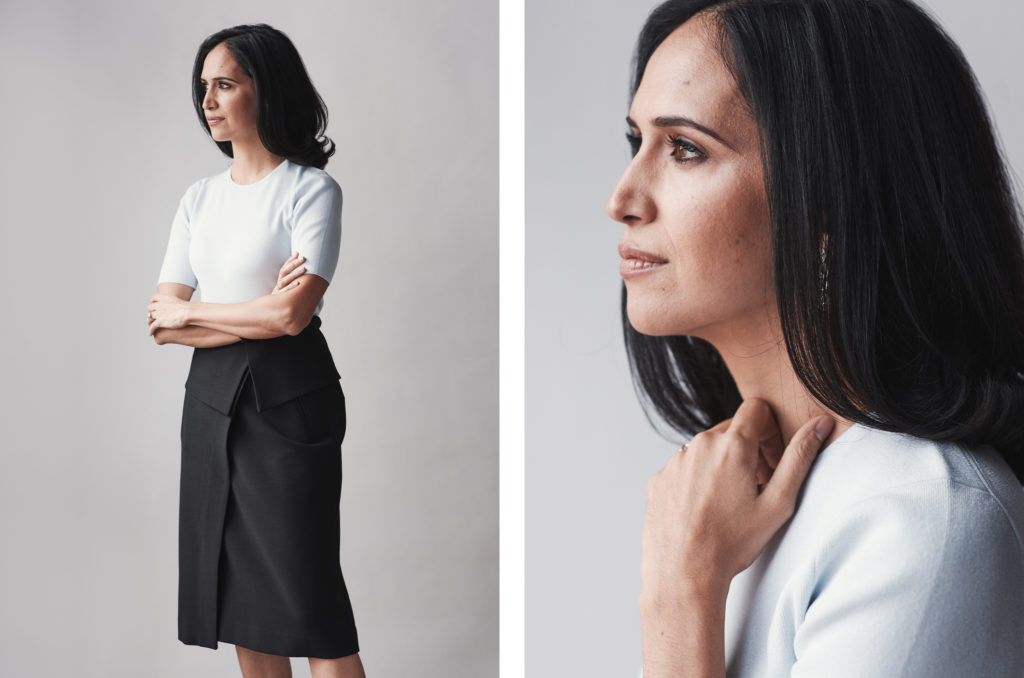Priya Parker Uses Her Training in Conflict Resolution to Make Gatherings More Meaningful
April 19, 2019 | Filed in: Woman of the Week
Priya Parker began her career in conflict resolution, working to facilitate dialogue between Hindus and Muslims in India. Then, after getting advanced degrees from Harvard and MIT, she realized that many of the ways we gather—both in and out of the workplace—weren’t nearly as powerful or meaningful as they could be. In her new book, The Art of Gathering, she provides a framework for ways to gather “better”—creating events that inspire deep connections, new ideas, and effective ways to address discord. Here, she tells us why being a “chill” host is a bad idea and how to lead a meeting with what she calls “generous authority.”

Priya wears the Hailey dress.
I WAS BORN IN ZIMBABWE to an Indian mother and a white American father. My mother is an anthropologist, and my father is a hydrologist. My first five years were spent moving to and from different towns and villages in Africa and Southeast Asia for my parents’ work. When we moved back to the U.S., to Virginia, my parents divorced. Within two years, they each remarried. They had joint custody, and so, for the second half of my childhood, every two weeks I’d go back and forth between two very different homes.
MY MOTHER’S HOME WAS INDIAN, BRITISH, VEGETARIAN, liberal, New Age-y, and incense-fueled. A mile away, my father’s home was evangelical Christian, conservative, meat-eating, church-going, and with multiple kids. My husband often jokes that it’s no wonder that I ended up in conflict resolution. My formative years led me to the questions I’m still asking: What does belonging mean? How do we create experiences that unite?

Priya wears the Masha dress and the Beauport earrings.
BIRACIAL WASN’T A WORD I EVER USED GROWING UP. In 2000, I started college at the University of Virginia, and suddenly everyone was asking me, “What are you?” At first, I didn’t understand the question. I was like, “I’m an American? I’m a woman?” But of course, they were really asking about my race. That question bothered me. I thought, “Why is that the first question people ask me? Why do they need to know ‘what’ I am in order to place me?” When I started talking about this to some older students, they said, “Priya, do something about this.”
I BEGAN TO RESEARCH STUDENT INITIATIVES to improve race relations on college campuses. I talked to other students and got an independent fellowship to study the history of desegregation at UVA. That same year, I also learned about a process called sustained dialogue, which is used in conflict resolution and was created by the late Hal Saunders, a diplomat who helped draft the Camp David Accords. He realized that even when governments create peace treaties, relationships on the ground don’t necessarily change. So he spent the second half of his career studying cultural conflicts, including race relations on college campuses. He launched sustained dialogue at Princeton University to address race relations there. When I met him, he agreed to bring the approach to UVA.

Priya wears the Choe top and the Montgomery skirt.
ON SEPTEMBER 10TH, 2001, a friend and I wrote a letter to the UVA community that we were starting sustained dialogue on campus. Then 9/11 happened. These events taught me something invaluable: A gathering starts before it begins. Our program created a psychological container that was quickly filled by something we hadn’t anticipated. Over the course of a year, I created, designed, and hosted three-hour race dialogues every other week. My question was, if we get together for the purpose of discussing race, can we begin to transform our relationships? If we can do that, can we begin to transform our culture?
I LEARNED THAT YOU CAN BEGIN TO TRANSFORM RELATIONSHIPS when you gather people for a specific reason that everyone understands. You’re not inviting people to a vague dinner and then surprising them by talking about race. You have to design a gathering tightly and invite people purposefully. You can also exclude people because they don’t serve the purpose in a direct way. The most powerful gatherings turned out to be the ones that were most specifically focused.

Priya wears the Hailey dress.
AFTER GRADUATION AND A STINT IN INDIA working for the Dalai Lama’s Peace Foundation, I felt a little bit lost. I thought about doing a Ph.D. in peace studies or a public policy program. Then a mentor said to me, “You’ve already done what most Ph.D. students in conflict resolution want to do. To really make a difference, you need to understand the language and systems of power.” So I went to the Kennedy School at Harvard, where I developed a much more sophisticated understanding of power and its structure. I also studied organizational design in a joint program at MIT, which is about how to effectively coordinate systems of people.
I ATTENDED A LOT OF DIFFERENT GATHERINGS. I’d sit in a room where wine glasses were placed just so, the food was gorgeous, and the setting was Instagram-worthy. But I’d still leave feeling empty. I was frustrated that there were meaningful things to discuss but we were talking about our vacation plans. A lot of these occasions can be improved with simple tweaks. People don’t have bad gatherings on purpose. They just focus on the wrong things. The purpose of my book is to remind people that to host, you don’t have to cook well. You don’t need to have fish knives. You don’t need to have a beautiful home. To host well, you need to understand how to create meaningful connections between people. I want to put meaningful connections back at the center of our gatherings. It’s urgent: we’re in a fractured age where the need to gather is more pressing than ever.

Priya wears the Masha dress and the Beauport earrings.
IN THE WORKPLACE, WE OFTEN DON’T NEED TO GATHER MORE. We need to gather better. And, in many cases, we need to gather less. If you’re hosting a meeting, the primary question is, ”what is the purpose of this meeting?” or “what is the desired outcome?” Those are powerful frames. Otherwise, people tend to think, “The purpose of the meeting is to catch up.” But what do you believe will come out of people catching up in person? Why can’t you do that over an email? You need to raise the bar if you’re meeting face to face.
MEETINGS SHOULD BE GENERATIVE. Something should come out of them that didn’t exist before. They should excite and thrill. Usually, they should involve a decision. Openings and closings matter. Here’s an example of the power of an opening: The surgeon Atul Gawande wrote about a study where surgical teams were required to introduce themselves before starting an operation. When everyone went around and said their names, error rates went down because people felt more comfortable speaking up if they saw something wrong.

Priya wears the Choe top and the Montgomery skirt.
A GATHERING IS A UNIT OF TIME. You have the ability to create a temporary alternative world for 60 minutes, or 50 minutes, or however long you have. However, back-to-back meetings are very common, and you may need to reset everyone because they still have the previous meeting in the heads. They may need a palate cleanser. So give them one: Pose a quick question that’s fun and gets people connected, and go around the table with it. In a workplace context, connecting people is not a “nice to have” before you “get to the real work.” What you will accomplish as a group is directly affected by whether its members feel seen. Many studies show the importance of psychological safety when it comes to taking an unpopular view, which is sometimes necessary for effectiveness.
EVERY GATHERING IS A SOCIAL CONTRACT. There’s an implicit promise and acceptance. Your invitation is your first promise. Give your gathering or meeting a name—“The Worn-Out Mom’s Hootenanny” is much more interesting than a girls’ night out. Or call it “15 Toasts to …” whatever the theme is, in the invitation. People will be intrigued by that and come ready for 15 toasts. If they aren’t comfortable for whatever reason, they can decline. Part of the artful gatherer tool kit is to signal what you’re hoping to do from the moment you send the invitation, so that your guests are giving a real yes. It’s much harder to spring something structured onto a person who doesn’t feel like they signed up for it.

Priya wears the Hailey dress and the Ginger pump.
IN THIS DAY AND AGE, I DON’T THINK WE’RE AT RISK of over-imposing structure in our social gatherings. Right now, the attitude of “chill” is threatening our gatherings from being meaningful, specific, and interesting. Our desire to please the most skeptical person in the room does not protect the most hopeful. In that sense, being “chill” is an act of self-preservation, and inherently selfish. Going out on a limb and taking a risk for the sake of connecting people is an act of generosity—I call it “generous authority.” Of course, structure doesn’t have to be totally rigid. Groups also have rhythms. There’s a crescendo and a decrescendo. These are usually 90-minute cycles, maybe two hours. You always reach a lull. That’s when you have to figure out “Does this group have another round in them?” Use your intuition—it’s more powerful than you think.
Photographs by Jeff Allen.





